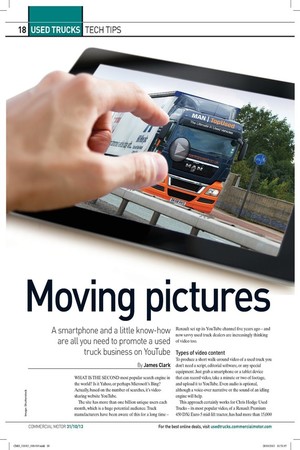Moving pictures
Page 14

Page 15

If you've noticed an error in this article please click here to report it so we can fix it.
A smartphone and a little know-how are all you need to promote a used truck business on YouTube By James Clark
WHAT IS THE SECOND most popular search engine in the world? Is it Yahoo, or perhaps Microsoft's Bing? Actually, based on the number of searches, it's videosharing website YouTube. The site has more than one billion unique users each month, which is a huge potential audience. Truck manufacturers have been aware of this for a long time —
Renault set up its YouTube channel five years ago — and now savvy used truck dealers are increasingly thinking of video too.
Types of video content
To produce a short walk-around video of a used truck you don't need a script, editorial software, or any special equipment. Just grab a smartphone or a tablet device that can record video, take a minute or two of footage, and upload it to YouTube. Even audio is optional, although a voice-over narrative or the sound of an idling engine will help. This approach certainly works for Chris Hodge Used Trucks — its most popular video, of a Renault Premium 450 DXi Euro-5 mid-lift tractor, has had more than 15,000
views in two years. Check out youtube.com/1chrishodge for almost 100 videos from Chris Hodge. Northern Commercials' three or four-minute product review videos are similar but with the addition of background music, a bit of editing, and a presenter talking to the camera (youtube.com//
NorComTV). And at the far end of the spectrum, Scania dealer Keltruck has uploaded a professionally produced
promotional video showcasing the company and its services (youtube.com/ user/keltruckltd/videos). With video production there is a
balance to be struck between cost and speed, quality and quantity, which will be different for each company. Whatever type of footage suits you, once
you have uploaded it to YouTube, there are a few steps you can take to ensure it reaches the audience possible.
• Complete the video information
Make sure you fill in the title field, the description, the tags, the category, and every other field available on YouTube. This will help users on the site find your
video while also helping search engines understand what your video is about. Video performs well for Google search results — did we mention YouTube is owned by Google? — but a helping hand never goes amiss.
It is possible to include web links in the description field, so why not use this to link your video back to a relevant page on your website? For example, a walk-around of a tractor unit could link to the 'tractor units' section of the site. That way, even when the item in question is sold, you will be helping buyers to find relevant alternatives.
• Style up your YouTube channel
Your channel is your public presence on YouTube and it is not possible to upload any videos without one. But not everybody realises that YouTube offers plenty of ways to customise the appearance of a channel, from organising videos into sections to adding a 'trailer' especially for new visitors. It is worth exploring all of these options.
For some inspiration, take a look at the major truck manufacturers' channels including Renault (youtube.com/ RenaultTrucksCom) and Scania (youtube.com/ scaniaunitedkingdom).
• Use your website
Your YouTube channel should work hand-in-glove with your company website. As a first step, follow Ryder's example (ryder.com) and use social media icons to link your website to your YouTube channel.
The next step is to embed your YouTube videos on your website. Chris Hodge (chrishodgetrucks.co.uk/ videos) does this particularly well, choosing one walk-around video to feature as Used Truck of the Week, another as Van of the Week, and making all other videos easily accessible on an online archive.
To embed a video from YouTube, go to the video page and click on the Share option just above the video description. Then click on the Embed option that appears below that. This will give you a small piece of code — called an embed code — which you can copy and paste into your website's back end.
• Don't forget social media
It's easy to send a tweet or post a Facebook update each time you upload a new video to your YouTube channel, and this can be made easier through automation. When logged into YouTube, go to YouTube Settings and then Connected Accounts — this will allow you to connect your YouTube, Facebook and Twitter accounts together, and decide what gets posted where.
The aim of all this activity on your website and across social media should be to build up the number of subscribers to your YouTube channel, so you can communicate with them en masse and encourage them to visit your website. Imagine notifying hundreds or even thousands of subscribers with a product video whenever you have new items in stock... CM's own YouTube channel (youtube.com/ roadtransport), which contains a mixture of product, news and promotional videos, has more than 2,500 subscribers and 12 million video plays — so there is a sizeable road transport-related audience out there. •









































